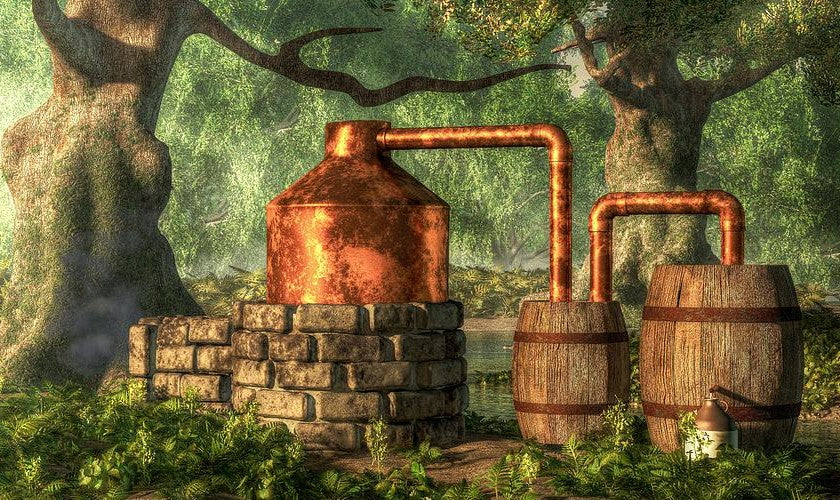
Forged in Tradition: The Legacy of Copper Alembic Stills in the Appalachian Mountains
Awaken To The OneShare
The History and Tradition of the Copper Alembic Still in the Appalachian Mountains
The Appalachian Mountains are known for their rugged beauty, diverse culture, and a rich history steeped in tradition. Nestled in the heart of these mountains, a time-honored craft has been passed down through generations, weaving a legacy of resilience, ingenuity, and an intimate relationship with the land: the distillation of spirits in copper alembic stills.
The copper alembic still, with its elegant curves and practical design, has long been an iconic tool for distilling. In Appalachia, it has evolved from its ancient origins to become a symbol of independence, creativity, and craftsmanship. But the story of this still is much more than a tale of spirits; it is a narrative of the region’s history, its people, and their enduring connection to the land.
In this blog post, we will explore the deep-rooted history of copper alembic stills in the Appalachian Mountains, tracing their evolution, cultural significance, and the role they played in shaping the community.
The Origins of the Alembic Still: Ancient Beginnings
The story of the alembic still begins long before it reached the remote hollows and ridges of the Appalachian Mountains. The origins of distillation can be traced back to ancient civilizations, where it was used for various purposes—most notably for the creation of perfumes and medicines.
-
Ancient Beginnings The alembic still itself has a history that stretches back to the ancient world. The earliest known examples of distillation equipment date to the ancient Egyptians and Sumerians, who used rudimentary stills for distilling perfumes and aromatic oils. By the 9th century, Islamic scholars like Al-Razi (Rhazes) and Ibn Sina (Avicenna) made important contributions to the development of distillation techniques, refining the alembic still into its more recognizable form.
-
Spread to Europe As trade routes expanded, the knowledge of distillation spread throughout Europe, where it became increasingly associated with the creation of alcoholic beverages. By the 15th century, distillation was being used to create spirits like brandy, and copper became the metal of choice due to its superior heat-conducting properties.
-
Arrival in Appalachia By the time settlers began arriving in the Appalachian Mountains in the 18th century, the copper alembic still was well-established in Europe. The mountainous terrain of the Appalachians, with its isolation and limited access to commercial distilleries, would soon make these stills a vital part of life for the region’s early inhabitants.
The Role of Copper Alembic Stills in Early Appalachian Distilling
When European settlers arrived in the Appalachian region, they brought with them their knowledge of distillation. However, the steep, remote environment required a great deal of self-sufficiency and ingenuity, especially when it came to producing alcohol. The copper alembic still became the perfect tool for the job, and distilling quickly became a part of Appalachian life.
-
Crafting the Still The stills used in Appalachia were often handmade by local blacksmiths or artisans. These early copper stills were relatively simple in design: a copper pot or boiler where fermented grains, fruits, or other sugars were heated; a swanneck pipe that led to a condenser, where the steam would be cooled and condensed back into liquid form; and a collection vessel for the resulting spirit.
The copper alembic stills were often hand-shaped, with every piece custom-crafted to suit the needs of the distiller. Copper, with its excellent thermal conductivity, was chosen for its ability to distribute heat evenly and efficiently, allowing for a more precise distillation process.
-
Moonshine and the "Art" of Distillation The mountainous, isolated regions of Appalachia were home to many small farms, and crops such as corn, rye, and barley were abundant. Due to the lack of nearby distilleries and the economic constraints of rural life, many families began distilling their own spirits as a way to make use of surplus crops. The moonshine that was produced in these copper alembic stills became a hallmark of Appalachian culture.
These homemade spirits were often unregulated and produced outside the reach of government taxes, which would lead to the rise of illegal distilling operations—known as "moonshining." The term "moonshine" is believed to have originated from the practice of distilling alcohol at night (or under the moonlight) to avoid detection. Despite its illegal status, the art of distilling in Appalachia flourished, with generations of families passing down their recipes, techniques, and knowledge.
Tradition, Culture, and the Survival of the Craft
While the practice of distilling spirits in the Appalachian Mountains may have originated from necessity and resourcefulness, it soon became woven into the region’s cultural fabric. Copper alembic stills were not just tools for making alcohol; they were symbols of Appalachian identity, resilience, and a connection to the land. The craft became a way for families to survive and thrive in an often harsh environment.
-
Survival and Self-Sufficiency In many ways, the distilling tradition in Appalachia was born out of necessity. The isolation of the region meant that families had to be self-sufficient, growing their own food, raising livestock, and finding ways to preserve their harvests. Making spirits from surplus crops was not only practical but also economically advantageous, as moonshine could be bartered or sold in local markets. This self-sufficiency gave the people of Appalachia a sense of independence and pride.
-
The Spirit of "The Still" Over time, the still itself became an emblem of Appalachian culture. The intricate process of distillation, passed down through generations, was viewed as an art form, requiring patience, skill, and an intimate knowledge of the materials involved. The craft was handed down father to son, often with little written record. Instead, knowledge of distilling was shared orally, and techniques were passed down by "word of mouth."
In many Appalachian families, distilling became a rite of passage. The still was often a sacred object, representing not just a way to make alcohol, but also a symbol of craftsmanship, ingenuity, and cultural pride. For those who learned to operate the still, it became a source of deep connection to the land, the past, and the community.
-
Cultural Significance The practice of distilling in Appalachia has remained deeply embedded in the region’s folklore, music, and identity. Appalachian music, especially the bluegrass and country traditions, often references moonshine and the still. Tales of illicit distilling, bootlegging, and the cat-and-mouse games with federal authorities have become part of the mythology of the mountains. Icons like NASCAR driver Junior Johnson have roots in moonshining, showing just how ingrained the tradition is in Appalachian history.
The Decline of Moonshining and the Legalization of Distilling
In the early 20th century, the practice of moonshining in the Appalachian region faced significant legal challenges. Prohibition, enacted in 1920, sought to outlaw the production, sale, and distribution of alcoholic beverages in the United States. This led to a surge in illegal distillation and bootlegging, as distillers in the Appalachian region continued to produce moonshine to meet demand. Many of these operations were highly secretive, with stills hidden deep in the mountains to avoid detection.
However, in the years following Prohibition, the government began to crack down on illegal distilling operations. With the eventual repeal of Prohibition in 1933 and the legalization of alcohol production, the traditional craft of distilling saw a transformation. Legal distilleries began to emerge, and some Appalachian moonshiners transitioned into legitimate businesses, creating legal brands of whiskey and spirits that proudly honored their heritage.
Today, copper alembic stills continue to be used by craft distillers in Appalachia, and many distilleries proudly advertise their ties to the region’s distilling traditions. The resurgence of interest in artisanal, small-batch spirits has brought the once-illegal practice into the mainstream, and distillers who use copper alembic stills are often celebrated for their commitment to craftsmanship and tradition.
Conclusion: The Enduring Legacy of the Copper Alembic Still
The copper alembic still is more than just a tool for distilling—it is a symbol of Appalachia’s spirit of independence, ingenuity, and craftsmanship. From its ancient roots in the Middle East to its adoption in the remote mountains of Appalachia, the alembic still has shaped the region’s history, culture, and economy. For the people of Appalachia, the still is not just about making spirits; it is about honoring the land, the past, and the generations that came before.
While the illegal moonshine operations of yesteryear have largely given way to legal distilleries, the tradition of distilling in copper alembic stills remains strong in the Appalachian region. It is a testament to the enduring resilience of the Appalachian people, who, through hard work, creativity, and an unbreakable bond with their land, have kept this ancient craft alive for centuries. The copper alembic still continues to be a symbol of pride, cultural identity, and a deep respect for tradition.
